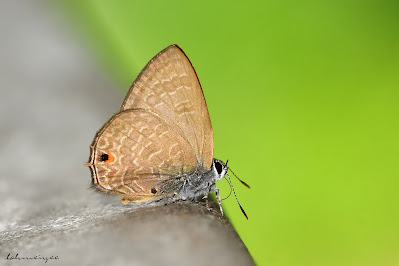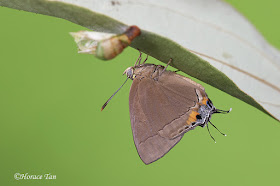The Ciliate Blue (Anthene emolus goberus)
A Ciliate Blue feeding on a damp wooden log
Time flies, and the month of May is almost over as we head for June and towards the end of the first half of 2023. The month of May belongs to the astrological sign Taurus. For those born between 20 April and 20 May, your zodiac sign is Taurus. We featured Capricorn, Aquarius, Pisces and Aries in the preceding Butterfly of the Month blogposts and will now move into the next in the series. The 12 zodiac signs are Aries, Taurus, Gemini, Cancer, Leo, Virgo, Libra, Scorpio, Sagittarius, Capricorn, Aquarius, and Pisces.
Taurus (♉︎) (Ancient Greek: Ταῦρος, romanized: Taûros, Latin for "bull") is the second astrological sign in the modern zodiac. The sign of Taurus is associated with several myths and bull worship from several ancient pagan cultures. It was established among the Mesopotamians, who called it "The Great Bull of Heaven,"
A Ciliate Blue feeding on the flower of the Bandicoot Berry (Leea indica)
Taureans are typically calm, patient, and kind. Adopting the characteristics of their zodiac symbol, the bull, they will start seeing red and keep charging on once they focus on an objective. They will be difficult to calm once provoked. They have a persistence and patience to see things through to their logical conclusions. Taureans can tend towards obstinacy in their outlook and their minds will be hard to change once they adopt a position.
Habits are a prominent theme for those born under the sign of the Bull, as their routines can help them be productive and organized. But when the habit has outlived its usefulness, they may stick to it long after it is necessary. A negative trait of a Taurean is that of being averse to change, and overly rooted in their ways and mindset. Though not particularly vengeful, Taurus' long memory may mean they seldom forget a slight or mistake, and it may take offenders a long time to earn back the Bull's trust, or to forgive someone who has betrayed them.
Our feature butterfly for the month of May 2023 is the common Ciliate Blue (Anthene emolus goberus). A small Lycaenid, this species has a wide distribution across Singapore, and exists in habitats ranging from urban greenery to mangrove areas, nature parks and the forested nature reserves. It is a fast-flying species, sometimes engaging in dogfights with another individual of the same species.
The upperside of the male Ciliate Blue is a deep purple blue whilst the females are generally dull brown with light blue wing bases. There are dark marginal spots at the tornal area of the hindwing. The underside is a pale greyish brown with a series of white striations on both wings. There is a large orange-crowned black marginal spot on the hindwing. A prominent black spot on the dorsum on the underside of the hindwing is a key characteristic of this species.
There are two species from the genus Anthene in Singapore. Both species are characterised by short fine tails which are extensions of the hindwing cilia. The other species, The Pointed Ciliate Blue, is the rarer of the two species found in Singapore, but both may frequent the same localities. The Ciliate Blue has solid jet-black eyes and the antennae are banded.
A Ciliate Blue puddling at a damp sandy path
Males of the species are sometimes found puddling on damp footpaths. An interesting behaviour of the species is that it is partial to human perspiration, and sometimes stays on a person for long periods of time, and keeps coming back to feed on the perspiration despite being chased away!
A Ciliate Blue laying eggs on the stem of its host plant. Note the cluster of green eggs and the Weaver Ant all ready to "farm" the caterpillars
The Ciliate Blue's caterpillars feed on a variety of host plants and can usually be found on Saraca thaipingensis (Yellow Saraca), Saraca indica (Ashoka Tree), Bauhinia sp., Smilax setosa (Sarsaparilla Vine), Senna fistula (Fabaceae, common name: Golden Shower), Senna alata (Seven Golden Candlesticks), Syzygium zeylanicum (Spicate Eugenia). Eggs are usually laid in clusters and the caterpillars are tended by Weaver Ants.
Text by Khew SK : Photos by : Gavin Chan, Khew SK, Ann Kong, Loh MY, Tan King How, Michael Soh, Horace Tan and Mark Wong























































